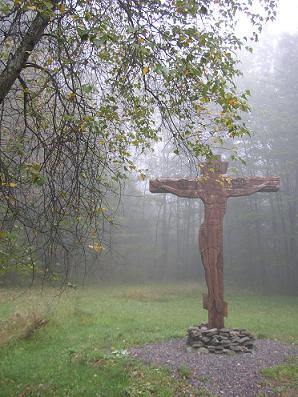Cross

The cross is the fundamental symbol for Christians, seen as the instrument of the world's salvation by the crucified Christ.
Contents
Emblem of victory
When Orthodox think of the crucified Christ, they think not only of his suffering and desolation; they think of him as Christ the Victor, Christ the King, reigning in triumph from the Tree. As heard in the first exorcism before Baptism: On the Tree he triumphed over the powers which opposed him, when the sun was darkened and the earth was shaken, when the graves were opened and the bodies of the saints arose. By death he destroyed death, and brought to naught him who had the power of death. The Church teaches that Christ is the victorious king, not in spite of the Crucifixion, but because of it: I call him king, because I see him crucified. (John Chrysostom)
Symbol of Christianity
Almost all liturgical objects are decorated with iconographic engravings, Christian symbols, and the sign of the cross. And each church building has, at its highest point, a cross.
The cross is the central symbol for Christians, not only as the instrument of the world's salvation by the crucified Christ, but also as the constant witness that one cannot be Christians unless they live with the cross as the very content of their lives in this world. If any man would come after me, let him deny himself and take up his cross and follow me (Mark 8:34).
The Holy Cross is a symbol of the New Testament, victory over death, and the intersection of the heavenly and the earthly.
Sign of the cross
For these reasons Christians place upon themselves the sign of the cross. The Orthodox place their first two fingers and thumb together to form a sign of the Triune God and cross themselves from the head to the breast and from shoulder to shoulder, right to left. This shows that the cross is the inspiration, power and indeed the very content of Christians life; and that one's mind, heart and strength must be given to the love of God and man.
Baptismal cross
Through Baptism we receive a full forgiveness of all sin; we put on Christ, becoming members of his body the Church. To be reminded of their Baptism, Orthodox Christians usually wear a small Cross, hung round the neck on a chain.
Veneration of the cross
After the final blessing with which the Liturgy ends, the people come up to kiss a Cross which the priest holds in his hand.
Twice a year the Cross is venerated in the center of the church.
The Exaltation of the cross
The Exaltation (or Raising Up) of the Honorable and Life-giving Cross (September 14).
Third Sunday of Lent
The Third Sunday of Lent is that of the Veneration of the Cross. The cross stands in the midst of the church in the middle of the Lenten season not merely to remind men of Christ's redemption and to keep before them the goal of their efforts, but also to be venerated as that reality by which man must live to be saved. He who does not take up his cross and follow me is not worthy of me (Matthew 10:38). For in the Cross of Christ Crucified lies both the power of God and the wisdom of God for those being saved (I Corinthians 1:24).
Crosses
Sometimes the style of a church building's main cross can reveal the makeup of the parish.
Triple bar cross
Many Orthodox Churches use a three bar cross. It has a short bar on the top that represents the sign that was placed on the cross. It read, "Jesus of Nazareth, King of the Jews". The middle bar, the longest, is the bar upon which Our Lord's arms were stretched and nailed. The bottom bar is the footrest which supported Our Lord's body.
It is often called a "Russian" cross, but it actually predates the Christianization of Russia in 988 AD, although generally, the bottom bar is horizontal rather than angled. Very early depictions of the crucifixion, even those originating in Egypt, generally portray the triple bar cross.
In certain parts of Central and Eastern Europe, the triple bar cross with a slanted footrest may indicate that a given church is an Orthodox one, while a triple bar cross with a horizontal footrest indicates that a given church is a Byzantine Rite, or Greek Catholic, one.
In Unicode, this cross is U+2626 (☦).
